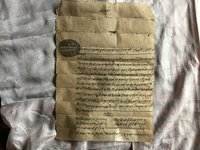A letter from Jagat Śamśera to dvāres of Aṭhāra Saya Kholā not to bother village headmen for their past actions (VS 1912)
ID: Tsum_0001_0006
Edited and
translated by Nadine Plachta and Rajendra Shakya
Created: 2017-05-10;
Last modified: 2018-09-18
For the metadata of the document, click here
The accompanying edition, translation/synopsis and/or commentary are available under the terms of the Creative Commons Attribution-ShareAlike 4.0 International License
Abstract
The letter concerns an order from Jagat Śamśera to the dvāres of Aṭhāra Saya Kholā to no longer bother the headmen of five named districts of Aṭhāra Saya Kholā, as they have already been absolved after paying a fine for their crime of lending help to the Tibetan army during Nepal’s war against its northern neighbor.Diplomatic edition
[1r]
1श्री५सर्कार∙2१[Seal of Jagat Śamśera]1स्वस्तिश्रीमद्राजकुमारकुमारात्मजश्रीजनरलजगत्सम्सेर∙जङ्गकुव़ोर∙णाजीक
2स्यपत्रम्¯¯¯ ¯¯¯ ¯¯¯ ¯¯¯ ¯¯¯ ¯¯¯ ¯¯¯ ¯¯¯
3आगे∙अठारसहेषोलामासालवसालद्वार्याभैजान्याद्वार्याहरुकेजेथोचित्उप्रांत
4निजअठारसहेषोलाकाअम्वलमध्ये∙पाचपार्वाकातपसिलवमोजिम्काघन
5सुंहरुले¯ ¯१¯कोर∙भोटकोलडाञिहुदा∙अठारसहेकाअम्वलमध्ये∙कुलुं
6भन्न्या∙लंगुरमा∙भोटकोषाम्पालिफौजवस्तानिजतपसिलवमोजिमकाघनसुं
7हरुले∙निजभोटकाषाम्पालिफौजलाई∙सातुसामल∙तिहुन्ताहुन्दियाकोर∙
8भोटकोभोट्यासिपाहिनिमाटेस्यां∙भोटवाटभागीआफ्नामुलुकमासरन्पि
9छापरिरैतिभैवस्याकालाई∙पछिभोटकाषाम्पालिफौजमासौपीदिन∙नजान्या
10वापत्∙निजअठारसहेषोलाका∙तपसिलवमोजिमकाघसुंलाई∙मोरु३५०डं
11डगरिछाडीदियाकोछ∙येस्कुरामाफेरिरैतिलाईटंटानगर∙फेरिटंटाग
12र्यौर∙रैतिकराउनआयाभन्याअैनबमोजिम∙गुताकारसमेत्वुझाउनपर्ला
13सोवुझिकामगर¯¯¯ ¯¯¯ ¯¯¯ ¯¯¯ ¯¯¯ ¯¯¯ ¯¯¯ ¯¯¯
14तपसिल
[table]
| छिलुंकोघनसुंव़ांजि | १ | निलुन्कोघनसुंनांगाम् | १ | |
| फुल्पेकोघनसुंफिन्जोनुर्वु | १ | नाककोघनसुंवोर्प्प | १ | |
| पारन्कोघनसुंछांडी | १ | १ |
18इतिसम्वत्१९१२सालमितिमाघवदि१३रोज२शुभ्म==========
Translation
[1r]
Śrī 5 Sarkāra - 1
Hail! A letter from General Jagat Śamśera Jaṅga Kũvara Rāṇā, the venerable prince born of a prince.
Āge: to the dvāres who are posted as dvāre in Aṭhāra Saya Kholā on yearly basis to [perform their duties].
Uprānta: among the ambalas1 of Aṭhāra Saya Kholā, the ghanasuṃs2 of Pācapārvā3 , during the war between [Śrī 5 Sarkāra]4 and Tibet, had provided sātu sāmala5 and tihun tāhun6 to the Khāmpālī7 army of Tibet while they had camped in the ridge (laṃgura) called Kuluṃ8 , and declined to go and hand over the Tibetan army man [named] Nimāṭesyaṃ9 who had been taking asylum in one’s own country [Nepal] as its citizen after escaping from Tibet. The ghanasuṃs of Aṭhāra Saya Kholā mentioned below have been absolved [from all accusations for these actions] after being fined mohara rupaiyā 350 as punishment. Do not bother the subjects regarding this issue again. If [you] bother them and the subjects come to complain [about this], [you] may, in accordance with the Ain, even have to pay the fine (gutākāra). [Hence] act accordingly.
[table]
| Ghanasuṃ Vāṃji of Chiluṃ10 | 1 | Ghanasuṃ Nāṃgām11 of Nilun12 | 1 | |
| Ghanasuṃ Phinjo Nurbu13 of Phulpe14 | 1 | Ghanasuṃ Vorppa15 of Nāka16 | 1 | |
| Ghanasuṃ Chāṃḍī17 of Pāran18 | 1 | 1 |
Monday, the 13th of dark fortnight of Māgha in the [Vikrama] era year 1912 (1856 CE). Auspiciousness.
Commentary
The names of the five district headmen locally known as ganchen also appear in some other documents with some variations in orthography. In documents Tsum_0001_0006 and Tsum_0001_0008, the names of the ganchens of five districts have been given, all of whom appear to be the same person except for the ganchen of Ṅāka Gāũ. The district seems to have witnessed changes in the leadership in the span of some six months. The earliest record that mentions the name of ganchen of Ṅāka dates back to 1856 CE, which mentions Vorppa as the ganchen. Some five months later, Dorjye is seen as ganchen of Ṅāka, while just a few weeks later, another person, Norbu, appears as the ganchen in another document.
The ganchen of Pāro Gāũ appears in seven documents with as many variations in orthography: Chyāṃ Ḍuḍup (Tsum_0001_0009), Chvāṅ Ḍaṃḍu (Tsum_0001_0042), Chāṃḍī (Tsum_0001_0006), Chyāṃ Ḍuṃḍu (Tsum_0001_0008), Chen Ḍaṃḍupa (Tsum_0001_0016), Chāṅa Ḍunḍupa (Tsum_0001_0032) and Chāṅ Ḍuṃḍu Bhoṭyā (Tsum_0001_0052). Likewise, the name of ganchen of Cule/Chiluṃ appears as Vāṃji (Tsum_0001_0006), Vāṅju (Tsum_0001_0008) and Vāṅjyū (Tsum_0001_0032).
The name of the ganchen of Nile/Niluṃ appears as Nāṃgām (Tsum_0001_0006), Nāṅmāṅ (Tsum_0001_0008) and Nāmgām (Tsum_0001_0032). The ganchen of Phurbe/Phulpe also appears in three documents: Phinjo Nurbu (Tsum_0001_0006), Phunjo Nurbu (Tsum_0001_0008) and Ḍupa Dorje Phunjo (Tsum_0001_0032).

